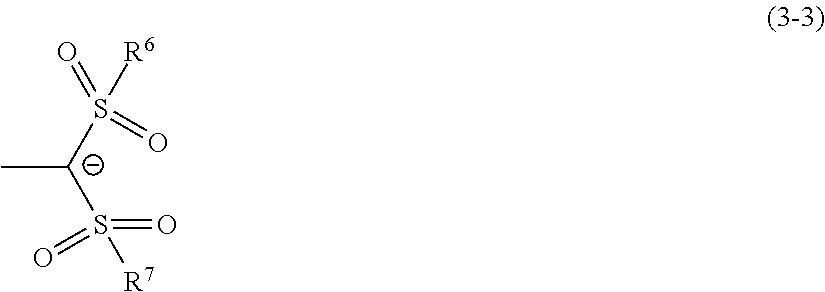Silicon Compound, Condensation Product, Resist Compostion and Pattern Formation Method
a technology of silicon compound and condensation product, which is applied in the direction of photosensitive materials, instruments, photomechanical equipment, etc., can solve the problems of unfavorable use of platinum catalyst, inability to efficiently introduce photoacid generating groups into silicon resins, and difficulty in removing platinum catalysts from silicon resins or alkoxysilanes used as raw materials of silicon resins, etc., to achieve high sensitivity, high insulating properties, and high acidity
- Summary
- Abstract
- Description
- Claims
- Application Information
AI Technical Summary
Benefits of technology
Problems solved by technology
Method used
Image
Examples
example 1
Production of Condensation Product (1)
[0170]In a three-neck flask with an impeller stirrer and a reflux condenser, total 30 g of a mixture of the alkoxysilane (1), tetraethoxysilane (abbreviated as “TEOS”), PhSi(OEt)3 and Me2Si(OEt)2 was placed in such a manner that the molar feed ratios of the alkoxysilane (1), TEOS, PhSi(OEt)3 and Me2Si(OEt)2 were 5 mol %, 10 mol %, 55 mol % and 30 mol %, respectively. Further, 150 g of isopropanol and 110 g of water as a solvent and 0.10 g of acetic acid as a hydrolysis catalyst were placed in the three-neck flask.
[0171]The resulting reaction system in the three-neck flask was subjected to hydrolysis and condensation reaction by heating at 90° C. After a lapse of 3 hours, the reaction solution was returned to room temperature. Upon addition of 200 ml of isopropyl ether and 200 ml of water into the three-neck flask, the reaction solution was stirred and thereby divided into two phases. The upper phase of the reaction solution was recovered and was...
examples 2 to 15
Production of Condensation Products (2) to (15)
[0172]The condensation products (2) to (15) were obtained by hydrolysis and condensation of the alkoxysilanes (1) to (5) with other alkoxysilanes in the same manner as in Example 1.
[0173]The feed ratios (molar ratios) of the alkoxysilanes and the measurement results of the weight-average molecular weights (Mw) are indicated in TABLE 1.
TABLE 1MolecularExam-CondensationCompositionweight pleproductFeed ratio (molar ratio)Mw11alkoxysilane (1):TEOS:PhSi(OEt)3:Me2Si(OEt)210505:10:55:3022alkoxysilane (1):MeSi(OEt)3:Ph2Si(OEt)29003:57:4033alkoxysilane (1):PhSi(OEt)3:MeSi(OEt)3:Me2Si(OEt)211505:40:25:3044alkoxysilane (2):TEOS:PhSi(OEt)3:Me2Si(OEt)210805:10:55:3055alkoxysilane (2):MeSi(OEt)3:Ph2Si(OEt)28803:57:4066alkoxysilane (2):PhSi(OEt)3:Me2Si(OEt)212005:70:2577alkoxysilane (3):TEOS:PhSi(OEt)3:Me2Si(OEt)29805:10:55:3088alkoxysilane (3):MeSi(OEt)3:Ph2Si(OEt)29503:57:4099alkoxysilane (3):PhSi(OEt)3:MeSi(OEt)3:Me2Si(OEt)212005:40:25:301010alkoxy...
PUM
 Login to View More
Login to View More Abstract
Description
Claims
Application Information
 Login to View More
Login to View More - R&D
- Intellectual Property
- Life Sciences
- Materials
- Tech Scout
- Unparalleled Data Quality
- Higher Quality Content
- 60% Fewer Hallucinations
Browse by: Latest US Patents, China's latest patents, Technical Efficacy Thesaurus, Application Domain, Technology Topic, Popular Technical Reports.
© 2025 PatSnap. All rights reserved.Legal|Privacy policy|Modern Slavery Act Transparency Statement|Sitemap|About US| Contact US: help@patsnap.com



